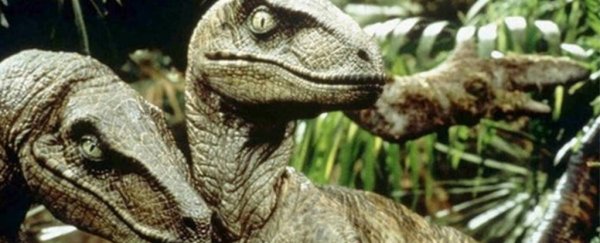The word "raptor" conjures the image of sleek, fearsomely clawed dinosaurs stalking prey with wolf-like social intelligence. But that nail-biting Jurassic Park kitchen scene, which made these prehistoric creatures so memorable, keeps being foiled by new scientific evidence.
First, reptilian scales gave way to feathers (not to mention the noises they made in the film turned out to be the sound of a tortoise having sex). Now, it seems these theropod dinosaurs were probably not social pack-hunters either.
"The problem with this idea is that living dinosaurs (birds) and their relatives (crocodilians) do not usually hunt in groups and rarely ever hunt prey larger than themselves," explained paleontologist Joseph Frederickson from University of Wisconsin Oshkosh.
 (Fred Wierum/Wikipedia/CC BY-SA 4.0)
(Fred Wierum/Wikipedia/CC BY-SA 4.0)
The idea that they may be pack hunters was proposed to explain evidence we've found of these wolf-sized predators feeding on prey much larger than themselves, such as the hefty Tenontosaurus tilletti.
Frederickson and colleagues analysed the teeth of the raptor species Deinonychus antirrhopus and ancient crocodilians that stalked North America during the Cretaceous period - 115 to 108 million years ago - to find clues as to how raptors really caught their dinners.
Their paper explains that social animals who hunt together provide parental care. This means babies share the same diet as their adult counterparts. But in species that do not hunt in groups, diets of young animals differ from adults - as the young are not capable of taking down the same prey.
For example, modern crocodilian species are known to switch from primarily insect prey as juveniles to relying more on fish and crustaceans as adults - or even large land animals like wallabies when it comes to Australia's freshwater crocodile (Crocodylus johnstoni).
Researchers can detect this change of diet in the composition of their teeth, through a shift in levels of carbon 13 isotopes.
Frederickson and colleagues found Cretaceous crocodilian teeth also had an equivalent change between small teeth from younger animals and larger teeth from adults. So they performed the same analysis on 20 D. antirrhopus teeth of different sizes, from two locations.
"The smallest teeth and the large teeth do not have the same average carbon isotope values, indicating they were eating different foods," said Frederickson. "This means the young were not being fed by the adults, which is why we believe Jurassic Park was wrong about raptor behaviour."
At the moment there are not enough teeth samples of D. antirrhopus to more vigorously analyse the solitary hunter idea, but this is a compelling clue. A 2007 study found evidence that at least one raptor was killed by another - not something that suggests cooperation, although not enough to rule it out, either.
The researchers believe the hunting style of raptors is closer to that seen in today's Komodo dragon, admittedly a far less romantic predator, but still rather impressive. These animals are capable of taking down water buffalo ten times their size.
But questions still remain, so we eagerly await to see what new evidence will change our understanding of raptors next.
This research was published in Palaeogeography, Palaeoclimatology, Palaeoecology.
